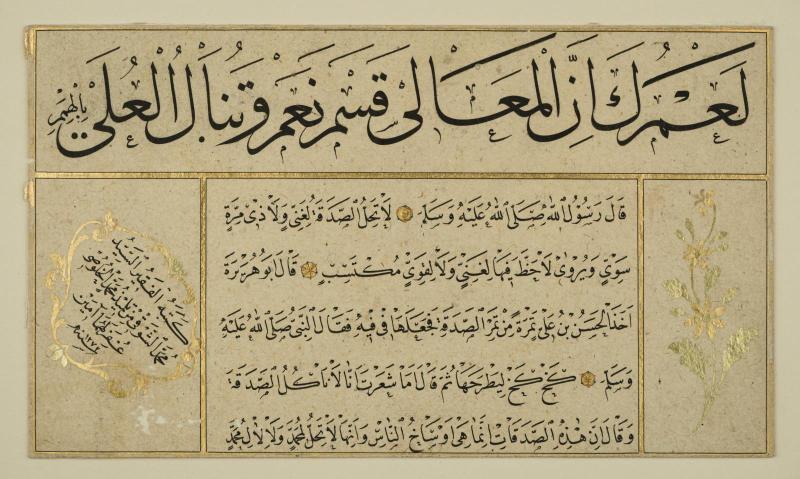Page with illuminated calligraphy
Karalamacı Hamdi Efendi
(Ottoman, died 1784)
1887 A.D./ 1304 A.H.
Object PlaceTurkey
Medium/TechniqueInk and gold on paper
DimensionsHeight x width: 11.6 × 20 cm (4 9/16 × 7 7/8 in.)
Credit LineHelen and Alice Colburn Fund
Accession number29.103
On View
Not on viewClassificationsBooks and manuscripts
Collections
Ottoman calligraphers often demonstrated their skills by writing different styles and sizes of Arabic script on rectangular sheets of paper, which were then illuminated and mounted on pasteboard. Known as qit'a, these calligraphic panels were commonly bordered with colored and marbled papers and assembled into accordion fold albums, known as muraqqaʿ. This calligraphic panel was composed by Ottoman calligrapher Hamdi Efendi (d. 1784), whose nickname, Karalamacı, literally translates to "Hamdi the scribbler." The nickname refers to the calligraphic exercises (karalama) intended to maintain the calligrapher's dexterity, for which Karalamacı Hamdi was most well known. Here, Karalamacı Hamdi used thuluth for the large text, naskh for the five small lines, and riqa' for the four lines written diagonally on the left side of the panel. An illuminator added floral decorations and verse markers decorated with blue, red, and white dots.
ProvenanceMiss Elizabeth (Riefstahl) Titzel (b. 1889 - d. 1986), New York; 1929, sold by Miss Elizabeth (Riefstahl) Titzel to the MFA for $5000.00 (total price for 29.56-136). (Accession Date: January 3, 1929)
Karalamacı Hamdi Efendi
18th century
Yedikuleli Seyyid ʿAbdullâh Efendi
1731 A.D./ 1141 A.H.
Ṣālih Efendi-zāde Meḥmed Emīn
about 1725
Mestçi-zâde Seyyid Mehmed Efendi
1783–84 A.D./ 1198–1199 A.H.
Recto early 16th century; verso about 1420–40; mounted in album about 1544–45
16th century
Ömer b. Abdurrahman
18th century
about 1500








